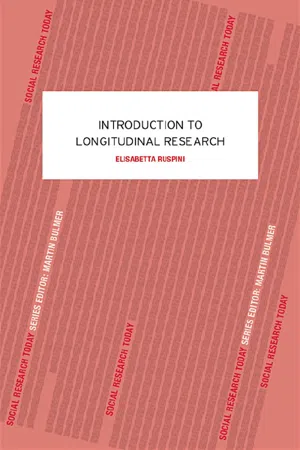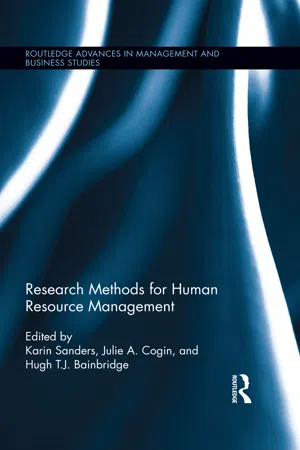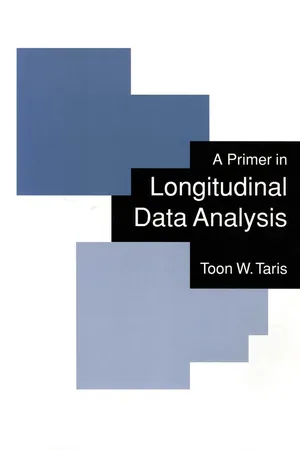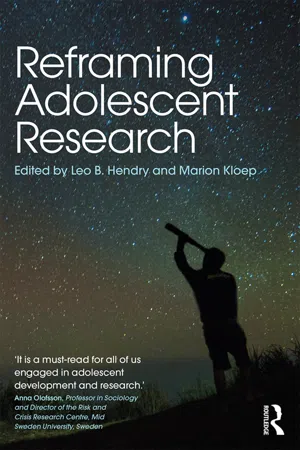Social Sciences
Longitudinal Studies
Longitudinal studies are research designs that involve collecting data from the same subjects over a period of time, allowing researchers to observe changes and development. These studies are valuable for understanding how individuals or groups change over time and for identifying patterns and trends that may not be apparent in shorter-term studies.
Written by Perlego with AI-assistance
Related key terms
7 Key excerpts on "Longitudinal Studies"
- eBook - ePub
Research Design
Succesful Designs for Social Economics Research
- Catherine Hakim(Author)
- 2012(Publication Date)
- Routledge(Publisher)
8 Longitudinal Studies DOI: 10.4324/9780203354971-8 Regular surveys and Longitudinal Studies are the two designs that most explicitly focus on social change processes, but they do so in different and complementary ways. Regular surveys provide information on net change at the macro-level, while Longitudinal Studies provide information on the much larger volume of gross changes (or flows) at the microlevel (see Chapter 7). Longitudinal Studies are often initiated when regular surveys or other sources reveal new trends that they cannot fully describe or explain (especially if they do not contain a panel element). The longitudinal study is unique in its ability to answer questions about causes and consequences and hence to provide a basis for substantiated explanatory theory. The prospective longitudinal study takes a single sample or group and follows it up, with repeated data collections, over a long period of time (see Figure 1). Strictly speaking, the term longitudinal study refers only to prospective studies. The retrospective study, which is quicker and cheaper, is considered below as a quasi-longitudinal design. Longitudinal Studies cover a ‘long’ period of time, although what is considered a long period of observation depends on the subject-matter and context, and the issues addressed. Studies of people experiencing a spell of unemployment may continue for only one or two years, while studies of human growth and maturation may continue for 30 years or longer. Generally, there are numerous data collections in order to collect information on changes as they are happening - eBook - ePub
- John Harrison, Michael Hoyler(Authors)
- 2018(Publication Date)
- SAGE Publications Ltd(Publisher)
Longitudinal urban research, which entails collecting data over extended periods of time, has the advantage over short-range projects of introducing a temporal element to the data increasing the explanatory power of empirical analysis (Ruspini, 1999). Such analysis facilitates distinguishing between transient and enduring processes occurring across all scales – from local to global – thus enabling identification of the changes that matter. In relation to global urban research, adopting a longitudinal approach can shed new light on issues such as: the impact of the global labour market and associated remittances; responses to global economic booms and crises; the influence of aspirations for and actual international mobility; the impact of rising global inequality; as well as changing urban–rural ties and trajectories of social and economic change in general.Although ‘longitudinal’ is a rather imprecise term, longitudinal data can be defined as ‘data gathered during the observation of subjects on a number of occasions over time’ (Ruspini, 2002: 3). There are several different research designs within longitudinal research: repeated cross-sectional studies, prospective studies and retrospective studies (Ruspini, 1999). In repeated cross-sectional studies, typically surveys are conducted at two or more points in time with a new sample population selected each time enabling a time trend to be incorporated into the analysis. Prospective longitudinal research typically involves panel surveys which trace individuals (often part of a cohort) at regular points in time enabling the nature of individual change to be analysed. Retrospective studies in contrast involve recording data in continuous time typically by conducting retrospective life histories over the entire life course.Longitudinal research can thus take on a range of differing characteristics. It may involve: continuous research in the same society over a number of years; re-studies that take place periodically either at regular or irregular intervals in ‘waves’; or return to a place/people after an extended period of time has elapsed. Whilst some longitudinal research is planned from the start as such, in other instances it emerges subsequently as a result of a researcher’s curiosity to discover how people and places have changed over time in contexts they once knew well (see, for example, Blaikie et al., 2002; Gugler, 1991; Moser, 2009; Perlman, 2010; Rigg and Salamanca, 2015; Ward, 2012). The fieldwork itself may entail the collection of quantitative data, qualitative data or combine the two in a mixed methods approach. Regardless of the specific research design, however, longitudinal research has the ability to ‘provide a glimpse into both the life histories of the individuals who make up a segment of a population, and the broader patterns of change that make up the social landscape’ (Brock and Knowles, 2012: 16). Thus a key strength of longitudinal research is the ability to link analysis of micro and macro processes over time. As Neale and Flowerdew claim: - eBook - ePub
- Elisabetta Ruspini(Author)
- 2003(Publication Date)
- Routledge(Publisher)
Part I Longitudinal research
Passage contains an image
1 What is longitudinal research?
The term ‘longitudinal’ will be used here to describe what can be defined as the minimum common denominator of a family of those methods which tell us about change at the individual micro level (Zazzo, 1967; Menard, 1991). This family is the opposite of that described by the term ‘cross-sectional research’.‘Longitudinal’ is a rather imprecise term. Longitudinal data can be defined as data gathered during the observation of subjects on a number of variables over time. This definition implies the notion of repeated measurements (van der Kamp and Bijleveld, 1998). Basically, longitudinal data present information about what happened to a set of units (people, households, firms, etc.) across time. The participants in a typical longitudinal study are asked to provide information about their behaviour and attitudes regarding the issues of interest on a number of separate occasions in time (called the ‘waves’ of the study) (Taris, 2000). In contrast, cross-sectional data refer to the circumstances of respondents at one particular point in time (I shall expand on these points later). Thus, the term ‘longitudinal’ refers to a particular type of relationship between phenomena: the type which evolves over the course of time and is termed diachronic, the opposite of synchronic - eBook - ePub
- Karin Sanders, Julie A. Cogin, Hugh T.J. Bainbridge(Authors)
- 2013(Publication Date)
- Routledge(Publisher)
Longitudinal ResearchTimothy C. BednallAfter reading this chapter, we expect you to be able to:- Understand the added value of using a longitudinal research design;
- Be able to design a longitudinal study, including the number, spacing, and timing of assessments;
- Gain an understanding of strategies for recruiting and retaining participants;
- Understand strategies for dealing with missing data;
- Test the assumption of longitudinal measurement equivalence;
- Understand the three major families of longitudinal research.
1 . Introduction
Longitudinal research refers to studies that investigate change over time. Usually, such studies involve repeated assessments of one or more variables of interest. This chapter provides an introduction to longitudinal research designs and discusses them within a structural equation modeling (SEM) framework. It discusses methodological challenges associated with developing and testing longitudinal models, and presents strategies for overcoming them. It provides an overview and examples of three major families of longitudinal research: (1) change score models, (2) autoregressive and cross-lagged panel models, and (3) latent growth models. Applications of these basic models are discussed. Other approaches to longitudinal data analysis are also briefly reviewed.2 . What is the Added Value of Longitudinal Research?
Longitudinal research offers numerous advantages over cross-sectional studies, in which data is collected only at a single point in time. In general, Longitudinal Studies allow researchers to determine how individuals typically change over time, including whether change is swift or gradual, and whether the rate of change remains constant. They permit researchers to determine whether other factors predict differences - eBook - ePub
- Toon W Taris(Author)
- 2000(Publication Date)
- SAGE Publications Ltd(Publisher)
1
Longitudinal Data and Longitudinal Designs
This chapter deals with some of the issues and complexities involved in the collection of longitudinal data. It aims to provide guidance, ideas, and perhaps some sense of confidence to investigators who expect a longitudinal design to help them in obtaining valid answers to their research questions, but are as yet uncertain about the best design for such a study. In this chapter I first distinguish between longitudinal research designs and longitudinal data, showing that the last does not necessary imply the first, and vice versa. After discussing some of the advantages of longitudinal data, seven basic designs for collecting such data are addressed. Finally, I provide a short checklist of the issues to be considered before undertaking a longitudinal study.Longitudinal data versus longitudinal designs
Basically, longitudinal data present information about what happened to a set of research units (such as people, business firms, nations, cars, etc.) during a series of time points (for simplicity, I will refer to human subjects throughout the remainder of this text). In contrast, cross-sectional data refer to the situation at one particular point in time. Longitudinal data are usually (but not exclusively) collected using a longitudinal research design. The participants in a typical longitudinal study are asked to provide information about their behavior and attitudes regarding the issues of interest at a number of separate occasions in time (also called the ‘phases’ or ‘waves’ of the study). The number of occasions is often quite small – Longitudinal Studies in the behavioral and social sciences usually involve just two or three waves. The amount of time between the waves can be anything from several weeks (or even days, minutes, or seconds, depending on the aim of a study) to more than several decades. Finally, the number of participants in the study is usually fairly large (say, 200 participants or over; sometimes even tens of thousands). - eBook - ePub
- Pamela Davies, Peter Francis(Authors)
- 2018(Publication Date)
- SAGE Publications Ltd(Publisher)
For researchers, money matters, and life-course research is usually expensive. It takes a lot of time, meaning more work and more research hours, and often creates (even) more methodological issues than most other forms of research in social science. It is therefore highly reasonable to pose the question and demand an answer from its advocates: why do this form of research at all, and why has it become so prominent over the last three decades?Because, using this methodology, we can answer important research questions which other methods have trouble addressing. The foremost questions in this regard concern the issue of continuity and change in behaviour over time.To contrast life-course research, consider so-called cross-section methodology. Here, researchers study a sample or a population at a single, specific moment in time. The resulting data gives us the possibility to study individuals or groups of individuals when it comes to a whole range of variables (such as crime, peer relations, health, employment, and so on), and how these are related to each other. We commonly call these between-individual similarities and differences. Using longitudinal methodology, we study the same individual at repeated points in time. Since we can study the relationship between the different variables as we go through time, we can also see whether the relationship between them is constant or changes over time. It is likely, for example, that as long as the individual engages in repeated, serious crime, he or she will have a relatively unstable form of conventional work (if he or she has a job at all), have turbulent relationships with other people, have increasing problems with mental and physical health, etc. Whether or not this is the case becomes impossible to study using cross-sectional research design – it would have to be inferred by theory.We can also study what happens when change occurs in one of the variables: is there a change in a person’s criminal offending when he or she gets a more stable job, starts a romantic relationship or becomes ill? Crucially, we can also – sometimes – study which change occurs before the other, i.e. does a person’s criminal offending change as a result of them getting a job etc., as Sampson and Laub (1993) argue, or is it the other way around – a person begins to decrease their criminal offending and then - eBook - ePub
- Leo B. Hendry, Marion Kloep(Authors)
- 2018(Publication Date)
- Routledge(Publisher)
Box 4.1 ), which at a general level boil down to two overarching questions: How does the same individual change over months and/or years (i.e. intra-individual or within-person change) and what are the causes of change (for a historical overview, see, e.g. Voelkle and Adolf, 2015). However, modern theories highlight (at least) two other rationales for longitudinal research: testing heterogeneity in developmental mechanisms (or inter-individual differences in the causes of intra-individual change) and assessing the non-stationarity of processes on different time scales (or changes in the cause(s) of intra-individual change over time). Could novel longitudinal research methods help researchers to set these conceptual steps?BOX 4.1 FIVE RATIONALES FOR LONGITUDINAL RESEARCH1 The direct identification of intra-individual change2 The direct identification of differences in intra-individual change3 The analysis of interrelationships in behavioural change4 The analysis of cause of intra-individual change5 The analysis of causes of inter-individual differences of intra-individual change(Baltes and Nesselroade, 1979)As researchers nowadays, we have the luxury of an almost overflowing toolbox of analytical techniques for longitudinal data, each of them with fancy names such as latent growth curve models (LGCM), growth mixture models (GMM) or random-intercept cross-lagged panel models (RICLPM). Moreover, new methods of collecting data continually emerge. For instance, with almost every teenager being equipped with a smart phone nowadays, we no longer have to rely on assessments with long intervals (i.e. the photo-album of development). We can also track adolescents as they go through their daily lives, by asking several times a day how they are feeling, behaving, and interacting with others. These so-called experience sampling methods (ESM; Larson and Csikszentmihalyi, 1983) are not new, but are increasing in popularity at a quite rapid pace (Hamaker and Wichers, 2017). The intensive longitudinal data or time series data that result from ESM studies can be used to obtain a ‘flip-book’ of short-term developmental processes. But rather than bringing us an easy fix to finally grasp the developmental mechanisms described in ecological and dynamic theories of development, this increase in methodological possibilities might actually be positively correlated with an increase in confusion among researchers.
Learn about this page
Index pages curate the most relevant extracts from our library of academic textbooks. They’ve been created using an in-house natural language model (NLM), each adding context and meaning to key research topics.






